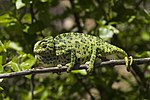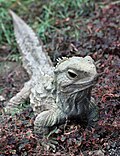having acrodont dentition. Rhynchocephalia: Acrodont tooth implantation is common within Rhynchocephalia, including Sphenodon. Amphibia: Acrodont tooth...
5 KB (456 words) - 10:44, 10 October 2024
sockets. There are, however, other animals that have acrodont dentition such as tuataras. Usually acrodonts are divided into two families Chamaeleonidae and...
8 KB (661 words) - 17:04, 8 October 2024
front and acrodont posterior teeth. Some rhynchocephalians differ from these conditions, with Ankylosphenodon having superficially acrodont teeth that...
53 KB (5,251 words) - 05:51, 29 October 2024
the rear. Most species are pleurodont, though agamids and chameleons are acrodont. The tongue can be extended outside the mouth, and is often long. In the...
69 KB (6,687 words) - 10:20, 12 October 2024
of bone, as seen in crocodilians, dinosaurs and mammals, and opposed to acrodont and pleurodont dentition seen in squamate reptiles. Notably, this appears...
1 KB (125 words) - 17:02, 30 November 2022
amphibians exhibit teeth that have a slight attachment to the jaw or acrodont teeth. Acrodont teeth exhibit limited connection to the dentary and have little...
42 KB (5,021 words) - 19:30, 7 November 2024
agamids is their teeth, which are borne on the outer rim of their mouths (acrodonts), rather than on the inner side of their jaws (pleurodonts). This feature...
15 KB (1,646 words) - 02:17, 20 August 2024
lizard to glide. While in its original description it was considered to acrodont lizard, with a cladistic analysis in the same study suggesting that it...
7 KB (643 words) - 21:31, 3 August 2024
but is not found among the non-archosaur reptiles, which instead have acrodont or pleurodont dentition. Teeth that were lost were replaced by teeth below...
39 KB (3,637 words) - 12:48, 12 September 2024
individual sockets (like in thecodonty) or without bone encasement (like in acrodonts and pleurodonts). It is known from several aquatic amniotes: ichthyosaurs...
1 KB (127 words) - 02:43, 11 September 2024








